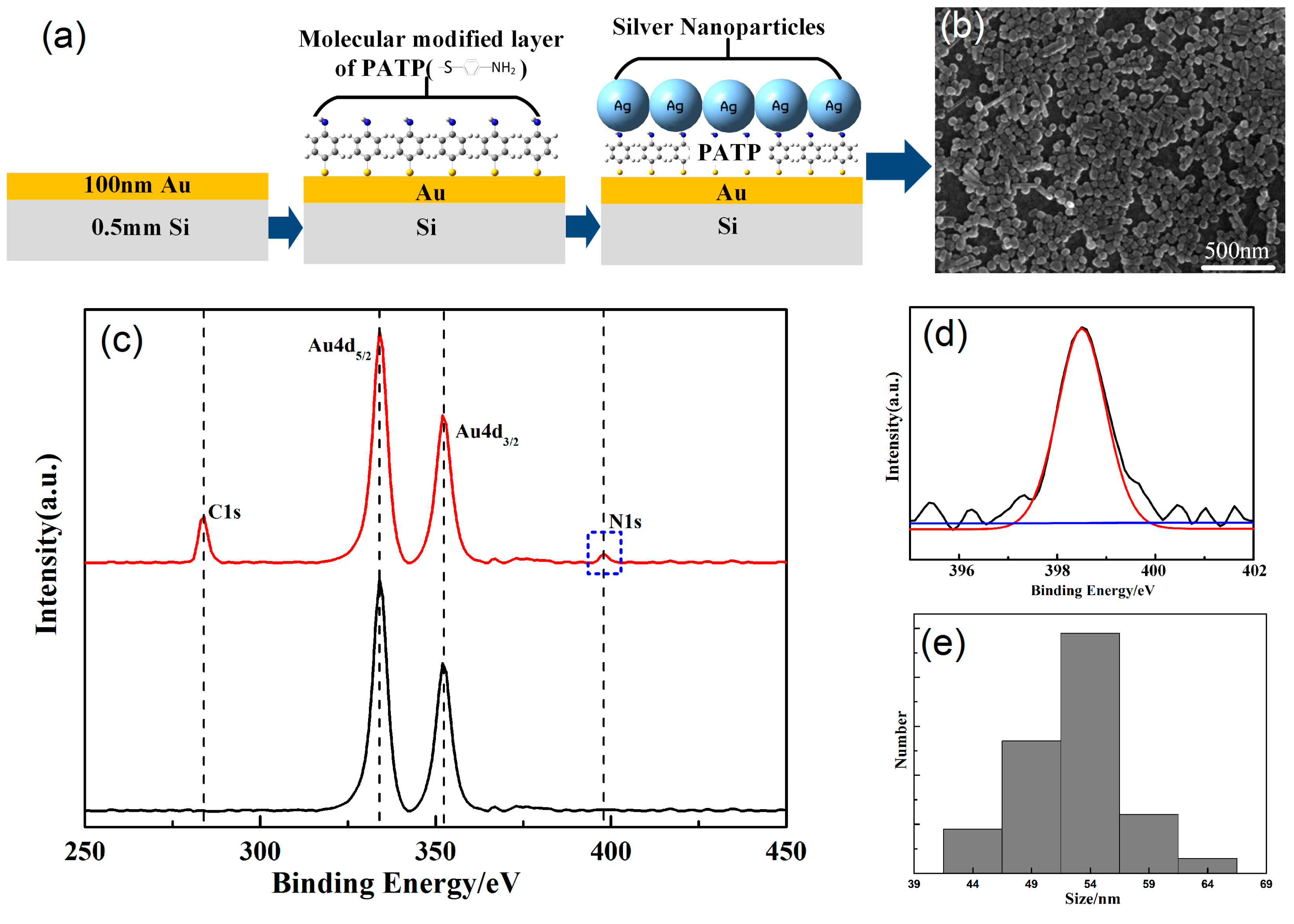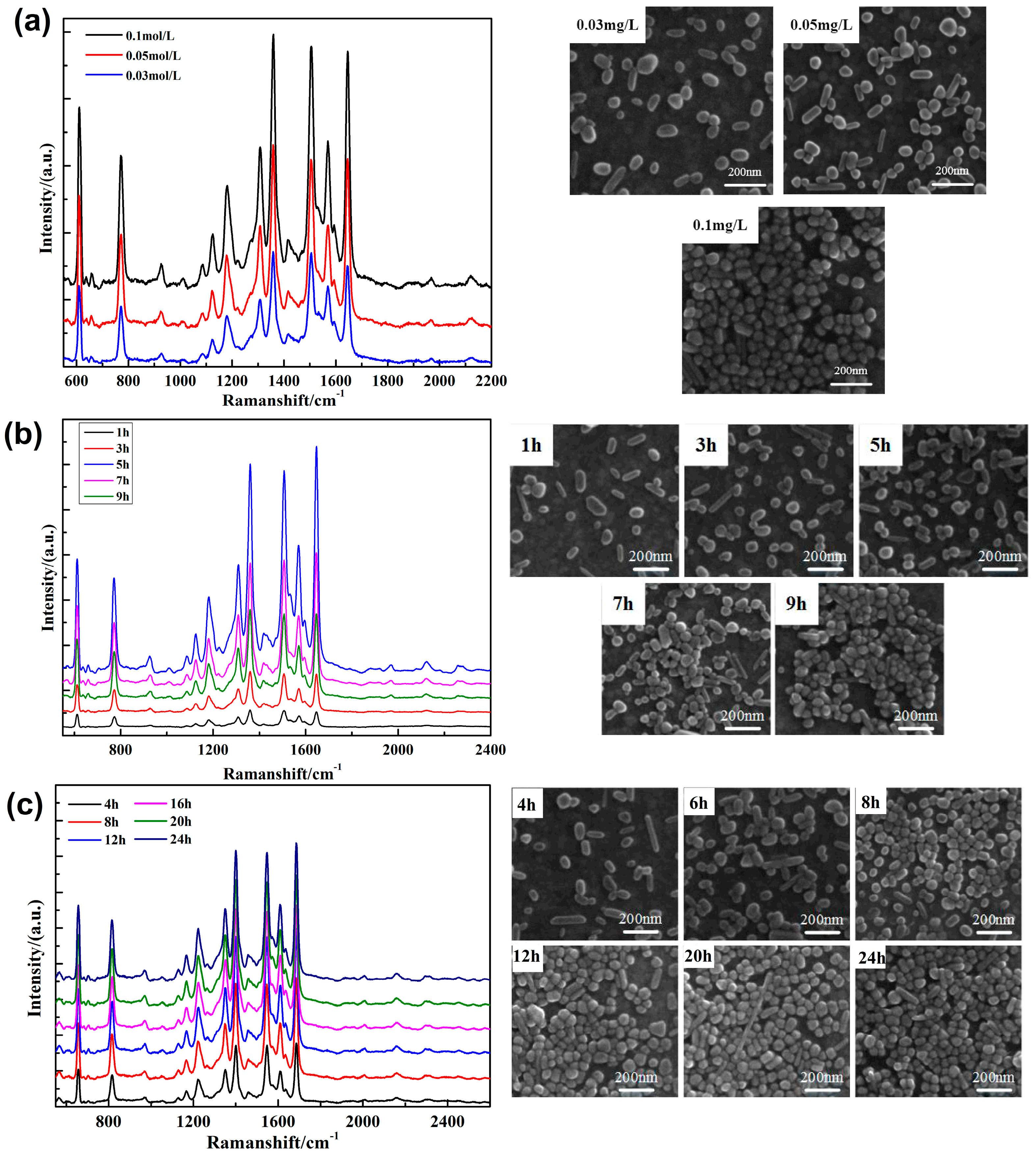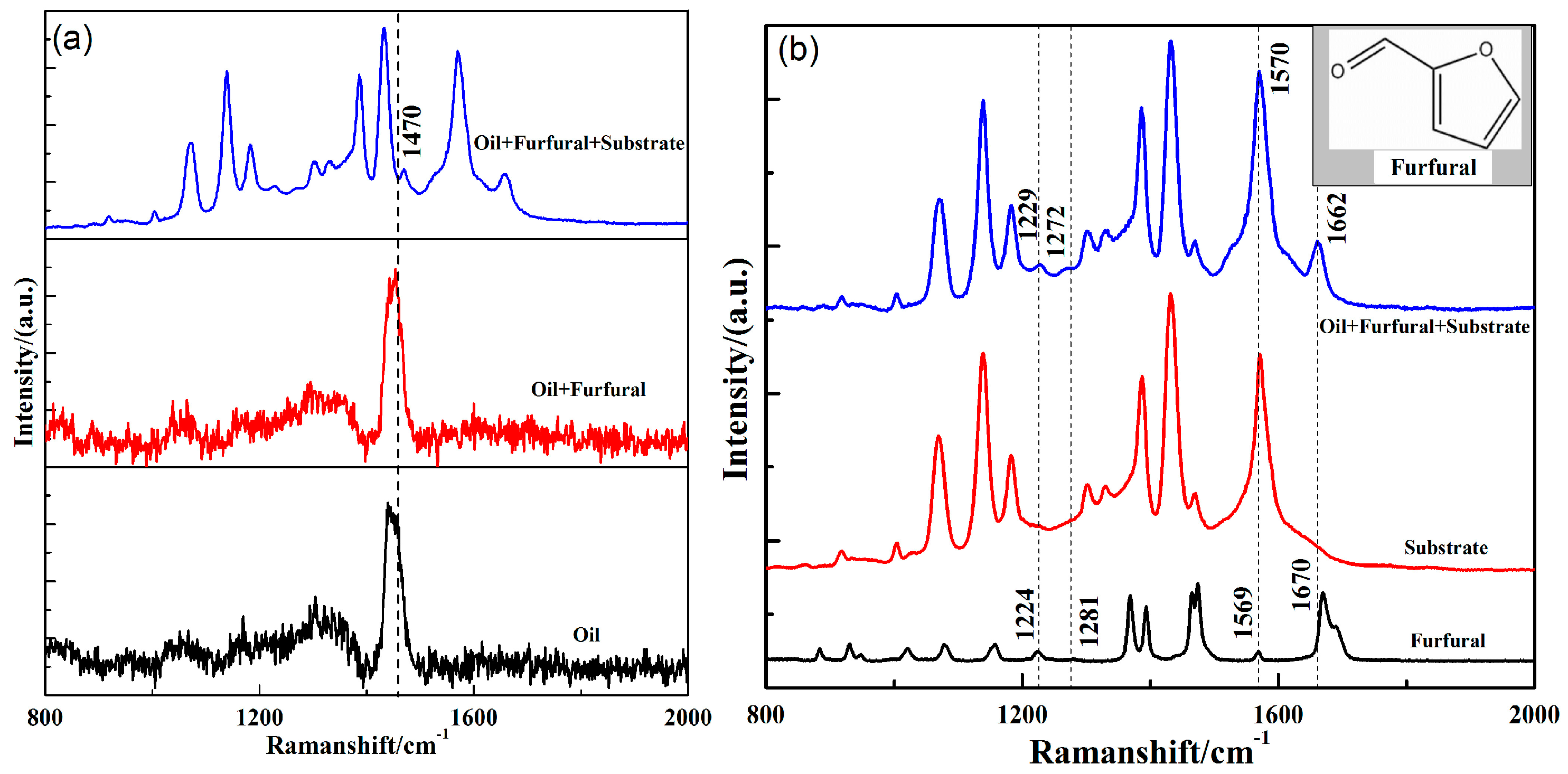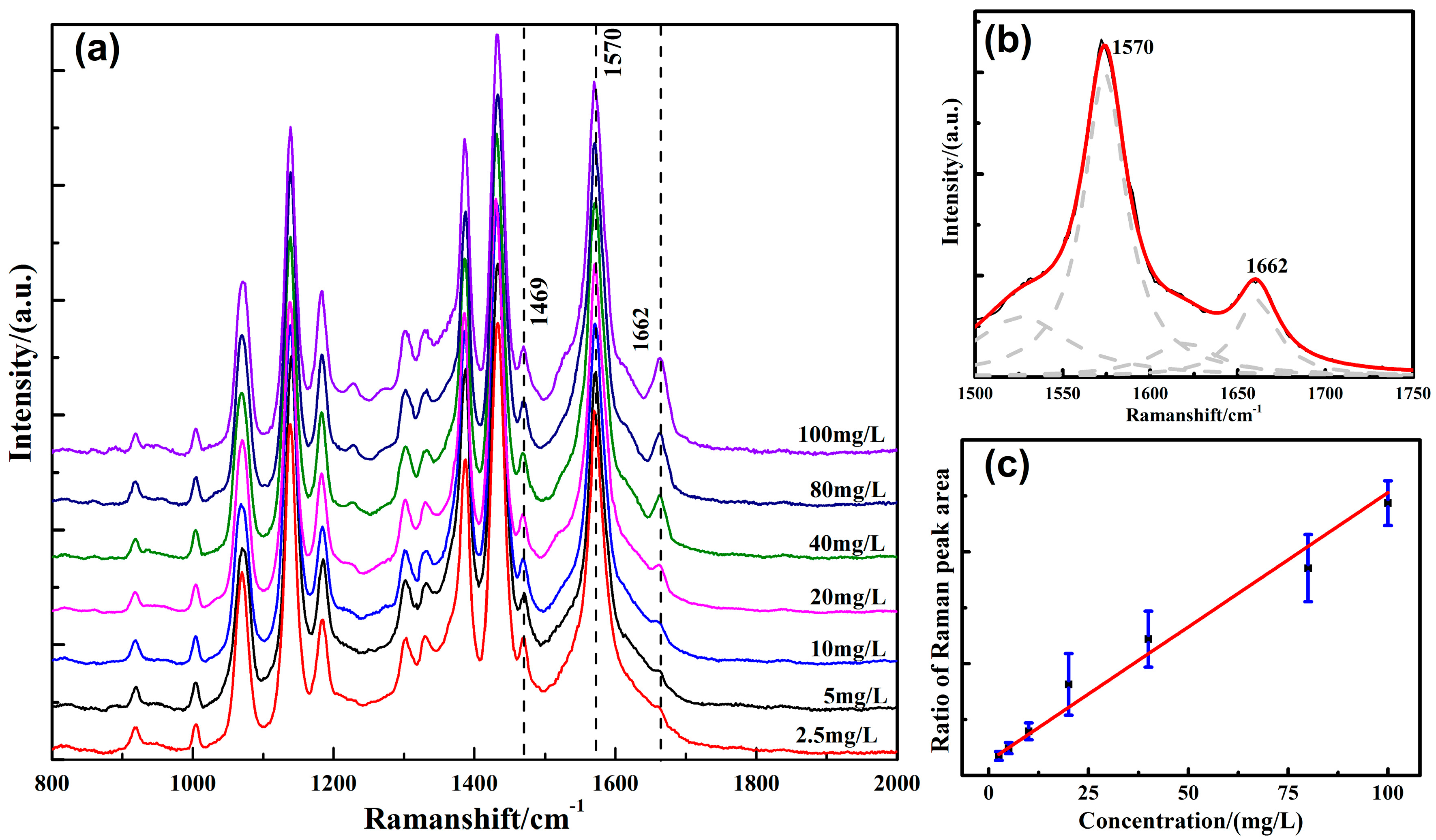Application of Self-Assembled Raman Spectrum-Enhanced Substrate in Detection of Dissolved Furfural in Insulating Oil
Abstract
1. Introduction
2. Experimental Part
3. Results and Discussion
4. Conclusions
Supplementary Materials
Author Contributions
Funding
Conflicts of Interest
References
- Shroff, D.H.; Stannett, A.W. A review of paper aging in power transformers. IEE Proc. C Gener. Transm. Distrib. 1985, 132, 312–319. [Google Scholar] [CrossRef]
- Lundgaard, L.E.; Hansen, W.; Linhjell, D.; Painter, T.J. Aging of oil-impregnated paper in power transformers. IEEE Trans. Power Deliv. 2004, 19, 230–239. [Google Scholar] [CrossRef]
- Arshad, M.; Islam, S.M.; Khaliq, A. Power transformer aging and life extensio. In Proceedings of the 2004 International Conference on Probabilistic Methods Applied to Power Systems, Ames, IA, USA, 12–16 September 2004. [Google Scholar]
- Shiri, A.; Gholami, A.; Shoulaie, A. Investigation of the ambient temperature effects on transformer’s insulation life. Electr. Eng. 2011, 93, 193–197. [Google Scholar] [CrossRef]
- Cleary, G.P.; Judd, M.D.; Farish, O. Investigation of partial discharge current pulses in transformer insulating oil. In Proceedings of the International Conference on Advances in Processing, Testing and Application of Dielectric Materials (APTADM’2001), Wroclaw, Poland, 17 September 2001. [Google Scholar]
- Fofana, I.; Bouaïcha, A.; Farzaneh, M. Characterization of aging transformer oil–pressboard insulation using some modern diagnostic techniques. Eur. Trans. Electr. Power 2013, 21, 1110–1127. [Google Scholar] [CrossRef]
- Lelekakis, N.; Wijaya, J.; Martin, D.; Susa, D. The effect of acid accumulation in power-transformer oil on the aging rate of paper insulation. IEEE Electr. Insul. Mag. 2014, 30, 19–26. [Google Scholar] [CrossRef]
- Oommen, T.V.; Prevost, T.A. Cellulose insulation in oil-filled power transformers: Part II maintaining insulation integrity and life. IEEE Electr. Insul. Mag. 2006, 22, 5–14. [Google Scholar] [CrossRef]
- Stebbins, R.D.; Myers, D.S.; Shkolnik, A.B. Furanic compounds in dielectric liquid samples: Review and update of diagnostic interpretation and estimation of insulation ageing. In Proceedings of the IEEE International Conference on Properties and Applications of Dielectric Materials, Nagoya, Japan, 1–5 June 2003; pp. 921–926. [Google Scholar]
- Unsworth, J.; Mitchell, F. Degradation of electrical insulating paper monitored with high performance liquid chromatography. IEEE Trans. Electr. Insul. 1990, 25, 737–746. [Google Scholar] [CrossRef]
- Pablo, A.D. Furfural and Ageing: How Are They Related Insulating Liquids; IET: Leatherhead, UK, 1999; pp. 1–4. [Google Scholar]
- Yang, L.; Lin, Y.; Liao, R.; Zhao, X.; Sun, W.; Zhang, Y. Effects of temperature and aging on furfural partitioning in the oil-paper system of power transformers. IEEE Trans. Dielectr. Electr. Insul. 2016, 23, 1393–1401. [Google Scholar] [CrossRef]
- Łojewski, T.; Sawoszczuk, T.; Łagan, J.M.; Zięba, K.; Barański, A.; Łojewska, J. Furfural as a marker of cellulose degradation. A quantitative approach. Appl. Phys. A 2010, 100, 873–884. [Google Scholar] [CrossRef]
- Arshad, M.; Islam, S.M. Significance of cellulose power transformer condition assessment. IEEE Trans. Dielectr. Electr. Insul. 2011, 18, 1591–1598. [Google Scholar] [CrossRef]
- Zhang, C.H.; Macalpine, J.M.K. Furfural Concentration in Transformer Oil as an Indicator of Paper Ageing, Part 1: A Review. In Proceedings of the IEEE Pes Power Systems Conference and Exposition, Atlanta, GA, USA, 29 October–1 November 2006; pp. 1088–1091. [Google Scholar]
- Dilleen, J.W.; Lawrence, C.M.; Slater, J.M. Determination of 2-furaldehyde in transformer oil using flow injection with pulsed amperometric detection. Analyst 1996, 121, 755–759. [Google Scholar] [CrossRef]
- Wang, R.; Huang, X.; Wang, L. Facile electrochemical method and corresponding automated instrument for the detection of furfural in insulation oil. Talanta 2016, 148, 412–418. [Google Scholar] [CrossRef] [PubMed]
- Pradhan, M.K.; Ramu, T.S. On the estimation of elapsed life of oil-immersed power transformers. IEEE Trans. Power Deliv. 2005, 20, 1962–1969. [Google Scholar] [CrossRef]
- Ministry of Power Industry. DL/T 596-1996, Electric Power Equipment Preventive Test Regulation; Ministry of Power Industry: Asinel, Spain, 1996.
- Jobstl, D.; Husoy, T.; Alexander, J.; Bjellaas, T.; Leitner, E.; Murkovic, M. Analysis of 5-hydroxymethyl-2-furoic acid (HMFA) the main metabolite of alimentary 5-hydroxymethyl-2-furfural (HMF) with HPLC and GC in urine. Food Chem. 2010, 12, 814–818. [Google Scholar] [CrossRef]
- Ahmadi, F.; Zarrin, L.; Sharifnia, S.; Hosseini, S.N. Analyzed and Proposed Mechanism of Photo-catalytic Degradation of Furfural at TiO2 Nano-particles by HPLC-UV and LC-MASS Methods. J. Liq. Chromatogr. Relat. Technol. 2014, 37, 1750–1762. [Google Scholar] [CrossRef]
- Zhang, Y.Y.; Song, Y.; Quan-Hong, L.I. A Review on Formation Mechanism, Determination and Safety Assessment of Furfural and 5-Hydroxymethylfurfural (HMF) in Foods. Food Sci. 2012, 33, 275–280. [Google Scholar]
- Chen, W.; Shi, H.; Wan, F.; Wang, P.; Gu, Z.; Li, W.; Ke, L.; Huang, Y. Substrate influence on the polarization dependence of SERS in crossed metal nanowires. J. Mater. Chem. C 2017, 5, 7028–7034. [Google Scholar] [CrossRef]
- Fu, W.; Shi, H.; Chen, W.; Gu, Z.; Du, L.; Wang, P.; Wang, J.; Huang, Y. Charge Transfer Effect on Raman and Surface Enhanced Raman Spectroscopy of Furfural Molecules. Nanomaterials 2017, 7, 210. [Google Scholar]
- Zang, Y.; Shi, H.; Huang, Y.; Zeng, X.; Pan, L.; Wang, S.; Wen, W. SERS Polarization Dependence of Ag Nanorice Dimer on Metal and Dielectric Film. Chem. Phys. Lett. 2017, 684, 373–377. [Google Scholar] [CrossRef]
- Li, W.; Jia, Y.; Liu, A.; Sun, X.; Su, X.; Zhang, X.; Li, K.; Huang, Y. Effects of substrate and polarization on plasmon driven surface catalysis in nanowire-film hybrid system. Superlattices Microstruct. 2016, 100, 886–891. [Google Scholar] [CrossRef]
- Huang, Y.; Fang, Y.; Zhang, Z.; Zhu, L.; Sun, M. Nanowire-supported plasmonic waveguide for remote excitation of surface-enhanced Raman scattering. Light-Sci. Appl. 2014, 3, e199. [Google Scholar] [CrossRef]
- Somekawa, T.; Fujita, M.; Izawa, Y.; Kasaoka, M.; Nagano, Y. Furfural analysis in transformer oils using laser raman spectroscopy. IEEE Trans. Dielectr. Electr. Insul. 2015, 22, 229–231. [Google Scholar] [CrossRef]
- Chen, W.; Gu, Z.; Zou, J.; Wan, F.; Xiang, Y. Analysis of furfural dissolved in transformer oil based on confocal laser Raman spectroscopy. IEEE Trans. Dielectr. Electr. Insul. 2016, 23, 915–921. [Google Scholar] [CrossRef]
- Fleischmann, M.; Graves, P.R.; Robinson, J. Enhanced and normal Raman scattering from pyridine adsorbed on rough and smooth silver electrodes. J. Electroanal. Chem. Interfacial Electrochem. 1985, 182, 73–85. [Google Scholar] [CrossRef]
- Li, Z.; Hao, F.; Huang, Y.; Fang, Y.; Nordlander, P.; Xu, H. Directional Light Emission from Propagating Surface Plasmons of Silver Nanowires. Nano Lett. 2009, 9, 4383–4386. [Google Scholar] [CrossRef]
- Huang, Y.; Fang, Y.; Sun, M. Remote Excitation of Surface-Enhanced Raman Scattering on Single Au Nanowire with Quasi-Spherical Termini. J. Phys. Chem. C 2011, 115, 3558–3561. [Google Scholar] [CrossRef]
- Sharma, B.; Frontiera, R.R.; Henry, A.I.; Ringe, E.; Van Duyne, R.P. SERS: Materials, applications, and the future. Mater. Today 2012, 15, 16–25. [Google Scholar] [CrossRef]
- Kneipp, K.; Wang, Y.; Kneipp, H.; Perelman, L.T.; Itzkan, I.; Dasari, R.R.; Feld, M.S. Single Molecule Detection Using Surface-Enhanced Raman Scattering (SERS). Phys. Rev. Lett. 1997, 78, 1667. [Google Scholar] [CrossRef]
- Stetciura, I.Y.; Yashchenok, A.; Masic, A.; Lyubin, E.V.; Inozemtseva, O.A.; Drozdova, M.G.; Markvichova, E.A.; Khlebtsov, B.N.; Fedyanin, A.A.; Sukhorukov, G.B.; et al. Composite SERS-based satellites navigated by optical tweezers for single cell analysis. Analyst 2015, 140, 4981–4986. [Google Scholar] [CrossRef]
- Ilkhani, H.; Hughes, T.; Li, J.; Zhong, C.J.; Hepel, M. Nanostructured SERS-electrochemical biosensors for testing of anticancer drug interactions with DNA. Biosens. Bioelectron. 2016, 80, 257–264. [Google Scholar] [CrossRef]
- Wang, H.; Liu, T.; Huang, Y.; Fang, Y.; Liu, R.; Wang, S.; Wen, W.; Sun, M. Plasmon-driven surface catalysis in hybridized plasmonic gap modes. Sci. Rep. 2014, 4, 7087. [Google Scholar] [CrossRef]
- Vo-Dinh, T. SERS chemical sensors and biosensors: New tools for environmental and biological analysis. Sens. Actuators B Chem. 1995, 29, 183–189. [Google Scholar] [CrossRef]
- Wang, P. Graphene-Plasmonic Hybrid Platform for Label-Free SERS Biomedical Detection. Ph.D. Thesis, UCLA, Los Angeles, CA, USA, 2015. [Google Scholar]
- Lee, C.H.; Tian, L.; Singamaneni, S. Paper-based SERS swab for rapid trace detection on real-world surfaces. Acs Appl. Mater. Interfaces 2010, 2, 3429. [Google Scholar] [CrossRef]
- Anema, J.R.; Li, J.F.; Yang, Z.L.; Yang, Z.L.; Li, S.B.; Zhou, X.; Fan, F.R.; Zhang, W.; Zhou, Z.Y.; Wu, D.Y.; et al. Shell-Isolated Nanoparticle-Enhanced Raman Spectroscopy: Expanding the Versatility of Surface-Enhanced Raman Scattering. Annu. Rev. Anal. Chem. 2011, 4, 129. [Google Scholar] [CrossRef]
- Rodal-Cedeira, S.; Montes-García, V.; Polavarapu, L.; Solís, D.M.; Heidari, H.; La Porta, A.; Angiola, M.; Martucci, A.; Taboada, J.M.; Obelleiro, F.; et al. Plasmonic Au@Pd nanorods with boosted refractive index susceptibility and SERS efficiency: A multifunctional platform for hydrogen sensing and monitoring of catalytic reactions. Chem. Mater. 2016, 28, 9169–9180. [Google Scholar] [CrossRef]
- GómezGraña, S.; FernándezLópez, C.; Polavarapu, L.; Salmon, J.B.; Leng, J.; Pastoriza-Santos, I.; Pérez-Juste, J. Gold Nanooctahedra with Tunable Size and Microfluidic-Induced 3D Assembly for Highly Uniform SERS-Active Supercrystals. Chem. Mater. 2015, 27, 8310–8317. [Google Scholar] [CrossRef]
- Jeong, C.; Kim, H.-M.; Park, S.Y.; Cha, M.G.; Park, S.J.; Kyeong, S.; Pham, X.H.; Hahm, E.; Ha, Y.; Jeong, D.H.; et al. Highly Sensitive Magnetic-SERS Dual-Function Silica Nanoprobes for Effective On-Site Organic Chemical Detection. Nanomaterials 2017, 7, 146. [Google Scholar] [CrossRef]
- Lee, P.C.; Meisel, D. Adsorption and surface-enhanced Raman of dyes on silver and gold sols. J. Phys. Chem. 1982, 86, 3391–3395. [Google Scholar] [CrossRef]
- Lin, Y.; Yang, L.; Liao, R.; Sun, W.; Zhang, Y. Effect of oil replacement on furfural analysis and aging assessment of power transformers. IEEE Trans. Dielectr. Electr. Insul. 2015, 22, 2611–2619. [Google Scholar] [CrossRef]
- Mehta, D.; Jariwala, H. Predication of Life of Transformer insulation by developing Relationship between Degree of Polymerization and 2- Furfural. Int. J. Sci. Eng. Res. 2012, 3, 1–4. [Google Scholar]




| Number | Ramanshift (cm−1) | Peak Assignment |
|---|---|---|
| 1 | 919 | Raman signal of substrate and transformer oil |
| 2 | 1004 | Raman signal of substrate and transformer oil |
| 3 | 1072 | Raman signal of substrate |
| 4 | 1139 | Raman signal of substrate |
| 5 | 1183 | Raman signal of substrate |
| 6 | 1229 | Raman signal of Furfural |
| 7 | 1272 | Raman signal of Furfural |
| 8 | 1301 | Raman signal of substrate and transformer oil |
| 9 | 1334 | Raman signal of substrate and transformer oil |
| 10 | 1386 | Raman signal of substrate |
| 11 | 1431 | Raman signal of substrate |
| 12 | 1469 | Raman signal of substrate |
| 13 | 1570 | Raman signal of substrate and Furfural |
| 14 | 1662 | Raman signal of Furfural |
| DP Value | Estimated Percentage of Remaining Life | Suggested Interpretation |
|---|---|---|
| 800 | 100 | Normal Ageing Rate |
| 700 | 90 | |
| 600 | 79 | |
| 500 | 66 | Accelerated Ageing Rate |
| 400 | 50 | |
| 380 | 46 | |
| 360 | 42 | |
| 340 | 38 | Excessive Ageing Danger Zone |
| 320 | 33 | |
| 300 | 29 | |
| 280 | 24 | High Risk of Failure |
| 260 | 19 | |
| 240 | 13 | End of expected life of paper |
| 220 | 7 | |
| 200 | 0 |
© 2018 by the authors. Licensee MDPI, Basel, Switzerland. This article is an open access article distributed under the terms and conditions of the Creative Commons Attribution (CC BY) license (http://creativecommons.org/licenses/by/4.0/).
Share and Cite
Shi, H.; Chen, W.; Wan, F.; Du, L.; Zhang, S.; Zhou, W.; Zhang, J.; Huang, Y.; Zhu, C. Application of Self-Assembled Raman Spectrum-Enhanced Substrate in Detection of Dissolved Furfural in Insulating Oil. Nanomaterials 2019, 9, 17. https://doi.org/10.3390/nano9010017
Shi H, Chen W, Wan F, Du L, Zhang S, Zhou W, Zhang J, Huang Y, Zhu C. Application of Self-Assembled Raman Spectrum-Enhanced Substrate in Detection of Dissolved Furfural in Insulating Oil. Nanomaterials. 2019; 9(1):17. https://doi.org/10.3390/nano9010017
Chicago/Turabian StyleShi, Haiyang, Weigen Chen, Fu Wan, Lingling Du, Shuhua Zhang, Weiran Zhou, Jiayi Zhang, Yingzhou Huang, and Chengzhi Zhu. 2019. "Application of Self-Assembled Raman Spectrum-Enhanced Substrate in Detection of Dissolved Furfural in Insulating Oil" Nanomaterials 9, no. 1: 17. https://doi.org/10.3390/nano9010017
APA StyleShi, H., Chen, W., Wan, F., Du, L., Zhang, S., Zhou, W., Zhang, J., Huang, Y., & Zhu, C. (2019). Application of Self-Assembled Raman Spectrum-Enhanced Substrate in Detection of Dissolved Furfural in Insulating Oil. Nanomaterials, 9(1), 17. https://doi.org/10.3390/nano9010017





